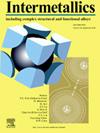使用由 Ni/Al-Al-FeCo/CrNi 填充金属组成的纳米多层箔在高温下实现高强度自蔓延钎焊 Al0.1CoCrFeNi 接头
IF 4.8
2区 材料科学
Q2 CHEMISTRY, PHYSICAL
引用次数: 0
摘要
开发了由 Ni/Al-Al-FeCo/CrNi 填充金属组成的新型纳米多层箔,用于钎焊 Al0.1CoCrFeNi 合金。这些采用高熵概念设计的镍/铝-铁-钴/铬镍(Ni/Al-FeCo/CrNi)填充金属被整合在一起,以增加混合熵并形成固溶体结构。这种战略性整合旨在防止金属间化合物的形成。通过改变保温时间和钎焊温度,研究了钎焊接头的微观结构演变和剪切强度。结果表明,由于混合熵较高,出现了固溶结构,从而形成了无缺陷的钎焊接头。随着温度的升高,固溶相对接头强化效果的贡献更加显著。钎焊接头在室温和 800 °C 下的最大剪切强度分别为 308.5 兆帕和 292.8 兆帕。此外,随着保温时间的延长和钎焊温度的升高,接头的剪切强度稳步提高,断裂机制也相应地从劈裂转变为延展。本研究介绍了一种新的 Al0.1CoCrFeNi 钎焊工艺,为高温(800 °C)下的制造业提供了一种技术范例。本文章由计算机程序翻译,如有差异,请以英文原文为准。

A high-strength self-propagating-brazed Al0.1CoCrFeNi joint at high temperatures with nano-multilayer foils composed of Ni/Al-Al-FeCo/CrNi filler metal
Novel nano-multilayer foils composed of Ni/Al-Al-FeCo/CrNi filler metals were developed for brazing Al0.1CoCrFeNi alloys. These Ni/Al-FeCo/CrNi filler metals, designed using a high-entropy concept, were integrated to increase the mixing entropy and form solid solution structures. This strategic integration was aimed at preventing the formation of intermetallic compounds. The microstructural evolution and shear strength of the brazed joints were investigated by varying the holding time and brazing temperature. The results demonstrated the formation of a defect-free brazing joint, marked by the emergence of a solid solution structure resulting from the higher mixing entropy. With increasing temperature, the contribution of the solid-solution phase to the strengthening effect on the joint was more significant. The maximum shear strengths of the brazed joints were 308.5 MPa and 292.8 MPa at room temperature and 800 °C, respectively. Furthermore, the extended holding time and increased brazing temperature produced a steady increase in the shear strength of the joint with a corresponding transformation in the fracture mechanism from cleavage to ductility. This study introduces a novel process for brazing Al0.1CoCrFeNi and offers a technological paradigm for manufacturing industry at a high temperature (800 °C).
求助全文
通过发布文献求助,成功后即可免费获取论文全文。
去求助
来源期刊

Intermetallics
工程技术-材料科学:综合
CiteScore
7.80
自引率
9.10%
发文量
291
审稿时长
37 days
期刊介绍:
This journal is a platform for publishing innovative research and overviews for advancing our understanding of the structure, property, and functionality of complex metallic alloys, including intermetallics, metallic glasses, and high entropy alloys.
The journal reports the science and engineering of metallic materials in the following aspects:
Theories and experiments which address the relationship between property and structure in all length scales.
Physical modeling and numerical simulations which provide a comprehensive understanding of experimental observations.
Stimulated methodologies to characterize the structure and chemistry of materials that correlate the properties.
Technological applications resulting from the understanding of property-structure relationship in materials.
Novel and cutting-edge results warranting rapid communication.
The journal also publishes special issues on selected topics and overviews by invitation only.
 求助内容:
求助内容: 应助结果提醒方式:
应助结果提醒方式:


